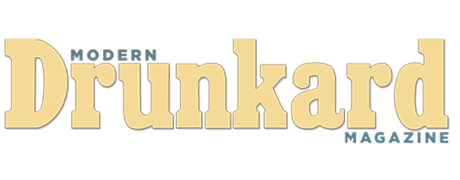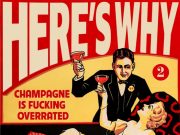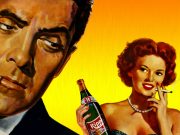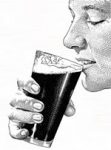From 2002 to 2003, I was a Guinness-tester in Dubai.
My official title was Stout Evaluative Engineer (SEE), though after a few hours of SEE-ing I could barely see. I’m not even sure it was a real title. We’ll come back to this.
In Dubai, Nightlife is worthy of a capital letter and a single name, like Madonna or Fabio. On any given night there are thousands of people—Muslim and non-Muslim—crowding the city’s bars, which are as diverse and specialized as in the West. The police generally turn a blind eye to public drunkenness and flamboyant revelry, though occasionally a gay bar will be shut down (homosexuality is prohibited) or arrests will be made for sex on the beach (the act, not the drink). The UAE wears two faces, but so do all nations. The government wants to appease the devout and sanctimonious, but they also want to lure tourists with luxury, entertainment, warm weather and a permissive atmosphere.
Alcohol is legal but technically only hotels and health clubs are permitted to operate bars. That said, I lived within walking distance of the Bunker, a free-standing dive in an otherwise empty lot. There were two barbells in the corner and a weed-infested swimming pool out back, warm enough to brew tea. No one ever swam in the pool or lifted a barbell, but perhaps their mere existence was enough to constitute a health club. Or maybe the Bunker was owned by a sheikh with enough wasta—power, coercive force—to do as he liked. Which might also explain a bowling alley in town that sold warm cans of Budweiser and the scores of gargantuan brothels, such as The Cyclone. Prostitution is illegal throughout the Emirates, but like many practices it’s quietly tolerated.
The city has state-run liquor stores. To shop here, you have to present an alcohol permit from the local police. All you need are two photos, a passport, a certified letter from an employer attesting to your salary, and 100 dirhams (about $25). On the faux-leather cover, underneath a majestic eagle, are the words: Just say Not to drugs.
I felt more like a Jager Girl than I would’ve liked, but after a covert Jim Beam double, I was nearly ready to untuck my Oxford shirt.
The amount of alcohol you can buy is keyed to your salary; the minimum salary limit excludes most of the foreign laborers who make up the majority of the population. This accounts for the furtive Subcontinentals lurking around after dark, bribing people to get them a bottle. The shops add a 30% tax to all sales, further marginalizing the working class.
There is an alternative, however, a semi-legal operation called the Barracuda in Ajman, a nearby Emirate. You drive up to a wooden beachfront shack—much like Rico’s surf shop in Hannah Montana—and point to your drink of choice. No license required. I stopped here for a case of San Miguel before a Halloween party at the American University of Sharjah. Later, at the university gates, I was stopped by security guards wearing red berets and clutching assault rifles. They were interested in the back of my jeep, where the beer was covered by my daughter’s Scooby Doo blanket. It’s illegal to transport alcohol into Sharjah, though it’s legal for non-Muslims to consume it on campus. (How to consume it at point A, without first transporting it there, is a paradox too dense to ponder.) The guards eventually stopped worrying over my jeep and turned their attention to me. I was dressed like Michael Jackson, with a veiled baby-doll that I planned to dangle from windows at the party.
The night proceeded without further incident. I won the costume prize and returned home with Elizabeth Taylor.
The next day, because of my part-time work as a reviewer for The Dubai Explorer, I was asked to be a Guinness-tester.
“Sure.” That’s all I could manage to say to Omar, my colleague at Zayed University. He gave me a time and date. That was my interview and training program. I should have asked follow-up questions, but instead I sat down and ate a chicken shawarma. I was in a fog after a long night of Jacksonian moonwalking and crotch-grabbing. I needed sleep and had a glove to iron.
The “work” was conducted during a pub crawl. Omar texted me the first location: Long’s Bar at the new Fairmont, across Sheikh Zayed Road from the Bunker. The Fairmont was a five-star hotel. Long’s had a 50-foot U-shaped walnut bar, many steps up from the Bunker, which featured stale Foster’s and a beer-sticky floor. Its star rating would not, in all likelihood, be a positive integer.
For a moment I thought the Beastie Boys were in town. Several men in white lab coats and goggles were dancing under a strobe light. On closer inspection, they were my new colleagues. Omar waved me over. It seemed as if the party, or workday, had already begun. Rahman—who appeared to be a short, bald, paunchy teenager—slapped a nametag on my shirt and handed me a goody bag. “Kit up, Andrew!” Presumably he was my supervisor.
The kit: lab coat, goggles, thermometer, ruler, beaker, Erlenmeyer flask, test tube, clipboard, pen. Against my better judgment, I got dressed.
There were nine of us. We met with the manager and head bartender. Instructions were given. Concise, vague instructions. Rahman called us together for high-fives. I’d gotten into academia almost exclusively to avoid high-fives.
Here’s how it worked: we were advised to laugh, “whoop it up” and dance—in a festive but not overtly drunken manner. I’m not sure what I’m less inclined to do, dance or whoop it up, but I was starting to feel nostalgic for high-fives. I felt more like a Jager Girl than I would’ve liked, but after a covert Jim Beam double, I was nearly ready to untuck my Oxford shirt.
Once we’d created a “party atmosphere,” the real work began. Assess the taste of the beer. Make notes. Use the glassware to rate color and consistency. We absolutely did not know what we were doing, though there was a science professor among us who claimed to be packing a swag of litmus papers for a pH test. At this point, a crowd was supposed to gather “to see what these crazy guys were up to.” Rahman encouraged us—I don’t want to admit this, so I’m whispering—to “vibe” with the bar patrons. Even with a PhD in English I don’t know what this means. A crowd gathered. I did engage socially with others. A woman began dancing with me in a manner that was uncomfortably enthusiastic.
We were supposed to take the temperature of our stout. 6-7 C (42-45 F) was ideal. Reading a thermometer in the dark is not easy. Especially while vibing. And stiff-arming frisky patrons.
After an hour, we moved on to Zinc. I tested my own drinks and those of the people I met. The temperature was usually off, and the taste was often bitter or slightly burnt. Dubai’s climate is no friend to alcohol, nor are the local slipshod methods of storage and transportation.
In the morning my clipboard notes looked like cuneiform. I wrote something new and emailed it to Rahman. I Guinness-tested once a month for a year. During this time I never stepped foot in a SEE office or met anyone who identified himself as a representative of Guinness & Co. If my testing notes were ever read—if they were analyzed, collated and distributed—I have no idea. I was paid in cash. Rahman didn’t have a business card. However, I enjoyed free drinks, a small stipend, and the feeling of a job I didn’t quite understand that was done not very well.
While my tenure as a SEE wound down, the Bunker was demolished to make way for the Burj Khalifa, the world’s tallest building. A bad trade-off, I’d say. It occurred to me that maybe I’d never been a legitimate Guinness-tester. Maybe I was just a guy in a lab coat sticking his thermometer in strangers’ beer.











